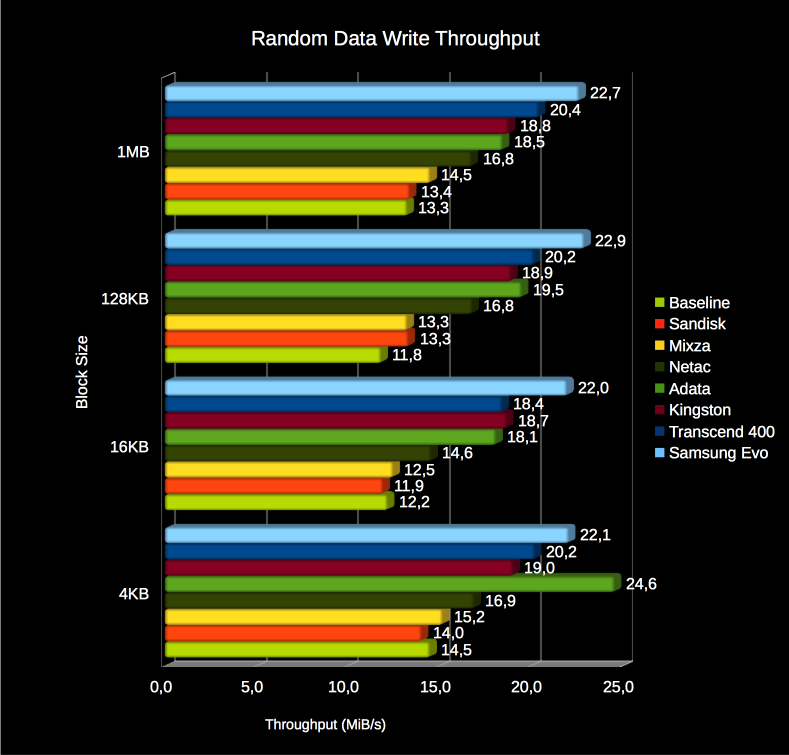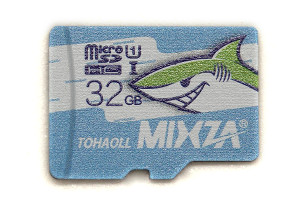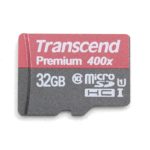After having reviewed a number of different microSD cards, the next step could only be compare then over a number of perspectives, each of them making sense to a significant number of users. Now, I believe it is quite obvious for everyone that there isn’t probably a best microSD card but it really depends on which parameters, or ratios between parameters are relevant for each one. Each of them will then represent an important benchmark by itself, so let’s detail each of them:
- Read Performance – The basic SD card benchmark, and targeted by most manufacturers. Although overlooked in some reviews, for a very relevant number of users this is the most important performance metric. If you use your Class10 card in a GoPro sport camera, or one of it’s clones, then this is the raw metric you’re looking for. For read performance comparison, we use the 16KB block size performance.
- Write Performance – Most people are concerned on this, mostly because this is the one which historically results on most issues and lower figures. There are a number of users which are mostly concerned over this, and most of them have a very recent high end DSRL camera with very fast continuos shooting. For write performance comparison, we use the 16KB block size performance.
- Formatted capacity – This is the most overlooked metric I’ve missed on most SD cards review, and probably due to the fact that reviewers don’t realize not all SD cards are made alike. Sometimes there is a 1GB difference between 32GB cards alone.
- Price – Price alone isn’t saying much, which being put into context. For comparison purposes the average of all available prices is used and converted into US$.
- Capacity to price ratio – The newest addition, and the most important for those users which don’t really care about performance, or are mostly concerned with bang for the buck.
- Performance to price ratio – Unless your father is Bill Gates, or your have unlimited budged, this shall be the figure you should be looking for.
Now, after introducing the relevant topics, let’s meet the contenders.
Meeting the contenders
All of the cards present on this shootout were specifically reviewed, but how they fared in comparison with others was missing. So, let’s recover the introductions for the cards and move on.
Benchmarking
Read Performance
Read performance gives an overlook on the quality of the SD controller implementation, and specifically on which SD bus is supported. In this case, we would see cards grouping themselves around each of the buses performance boundaries: 25MiB/s, 50 MiB/s and 104 MiB/s.

Et voila… you can clearly distinguish the expected three groups of SD cards:
- Cards supporting SD High Speed bus (SDR25 or UHS25), including our baseline SD card (supporting the state of the art at the time) and the Mixza card, which is extremely disappointing. These cards top at around 22 MiB/s or 88% of theoretical maximum bus performance.
- Cards supporting UHS50 bus, including all our big brands from Samsung and Sandisk, and no one else. Why on earth are only the big brands on this group of intermediate performance fails any kind of logic. On top of this, we already know that Sandisk already manufactures SD cards supporting the faster bus, at the same price point: the Adata card. Anyways, the way both Sandisk and Samsung cards achieve almost exactly the same performance values, at 43MiB/s is uncanny, making us suspect that both use exactly the same SD controller.
- Cards support UHS104 bus, which corresponds to the bigger chunk, including Transcend, Netac, Adata and Kingston. However this is the group having bigger performance differences, of around 15% between the faster and the slower card. This may be due to SD controller performance or low level flash performance. As there is no information available on flash, we’ll probably never know for sure.
The point is, if your thing is read performance, only the SC cards support UHS104 bus will suit your needs: Transcend 400x, Netac, Adata and Kingston. What is most striking here is how much technology has evolved into multiplying performance by 3 fold, when we compare the faster SD card with our baseline. It’s also worth noticing how major brands such as Samsung and Sandisk are absent from this group…
Write operations is where most low cost SD cards fall to their knees, and as it directly depends on the flash quality and hence cost, what most affects the selling price.

Write performance is where we set apart kids from grown-ups, and how evident this is. Ignoring that off-the-scale value on the 4K block size from Adata, which we consider a measurement mistake, this chart is completely dominated by Samsung, which if you think of it is quite natural. Samsung is the biggest flash manufacturer in the world, and probably supplies most flash devices on the reviewed SD cards. It’s then only natural that on the products is sells offers the highest quality and performance coming out of it’s factories.
Right next, with a 10% disadvantage, we have Transcend, and this is an important position, as it’s the first SD card to be present on both Read and Write podiums, and again with another 5% down, Kingston and Adata. It’s then worth noticing that it is possible to have high read and write performance within the same low end product.
Going lower on the rankings, we can find Netac right in the middle of the performance range, with around 25% performance than the Samsung card, the finally the lower performance group of cards, which includes Sandisk, Mixza and our baseline. The delta between the highest performant card and our baseline is less than 50% which is somewhat a disappointment, but the capacity increate is impressive, up to 10 fold.
[showad block=2]







